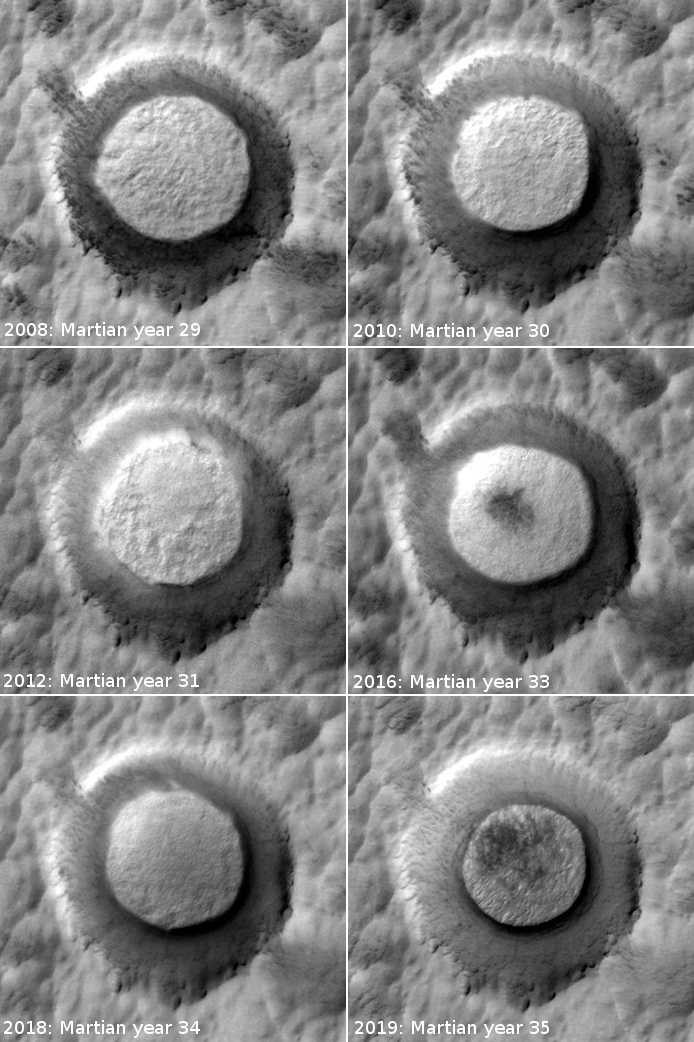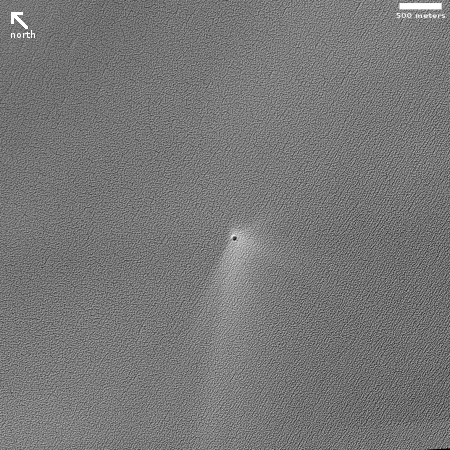Six Martian summers at a polar impact crater
Cool image time! The science team for the high resolution camera on Mars Reconnaissance Orbiter (MRO) last week released a very neat short movie compiled from images taken of an impact crater located on top of the northern polar ice cap of Mars. As noted by planetary scientist Alfred McEwen of the Lunar & Planetary Laboratory in Arizona in the image caption,
Shown here is an impact crater on the north polar ice cap, which contains an icy deposit on the crater floor. These inter-crater ice deposits shrink and expand or change shape or surface texture from year to year,
The image on the right, cropped and reduced to post here, is the most recent of these six images. The crater, which is about 200 feet in diameter, is the black speck in the center. The white streaks to the south of the crater, similar on all six photos, indicate that the prevailing winds come from the pole.
The animation zooms in on the crater so that you can see the details on its crater floor. And though the animation is fun, below the fold is a collage of all six photos, which I think makes it easier to see how the inter-crater ice deposits changed from summer to summer.

All the images were taken mid-summer. The differences are probably because of the sublimation of the dry ice layer that falls as snow in the winter and disappears during the summer. As that carbon dioxide sublimates away it often leaves dark patterns.
At the same time the randomness of these dark patterns, which do not appear to arrive at exactly the same time each summer, suggests that in this crater the timing of the dry ice sublimation can be somewhat random.
It is also possible that we are simply looking at random deposits of dust on the surface of the ice inside the crater.
Or maybe we just don’t have enough data to tell.
If you want to take a look at all the images of this crater taken by MRO, as well as several that are not part of the animation/collage, you can find them as follows:
On Christmas Eve 1968 three Americans became the first humans to visit another world. What they did to celebrate was unexpected and profound, and will be remembered throughout all human history. Genesis: the Story of Apollo 8, Robert Zimmerman's classic history of humanity's first journey to another world, tells that story, and it is now available as both an ebook and an audiobook, both with a foreword by Valerie Anders and a new introduction by Robert Zimmerman.
The print edition can be purchased at Amazon or from any other book seller. If you want an autographed copy the price is $60 for the hardback and $45 for the paperback, plus $8 shipping for each. Go here for purchasing details. The ebook is available everywhere for $5.99 (before discount) at amazon, or direct from my ebook publisher, ebookit. If you buy it from ebookit you don't support the big tech companies and the author gets a bigger cut much sooner.
The audiobook is also available at all these vendors, and is also free with a 30-day trial membership to Audible.
"Not simply about one mission, [Genesis] is also the history of America's quest for the moon... Zimmerman has done a masterful job of tying disparate events together into a solid account of one of America's greatest human triumphs."--San Antonio Express-News
Cool image time! The science team for the high resolution camera on Mars Reconnaissance Orbiter (MRO) last week released a very neat short movie compiled from images taken of an impact crater located on top of the northern polar ice cap of Mars. As noted by planetary scientist Alfred McEwen of the Lunar & Planetary Laboratory in Arizona in the image caption,
Shown here is an impact crater on the north polar ice cap, which contains an icy deposit on the crater floor. These inter-crater ice deposits shrink and expand or change shape or surface texture from year to year,
The image on the right, cropped and reduced to post here, is the most recent of these six images. The crater, which is about 200 feet in diameter, is the black speck in the center. The white streaks to the south of the crater, similar on all six photos, indicate that the prevailing winds come from the pole.
The animation zooms in on the crater so that you can see the details on its crater floor. And though the animation is fun, below the fold is a collage of all six photos, which I think makes it easier to see how the inter-crater ice deposits changed from summer to summer.

All the images were taken mid-summer. The differences are probably because of the sublimation of the dry ice layer that falls as snow in the winter and disappears during the summer. As that carbon dioxide sublimates away it often leaves dark patterns.
At the same time the randomness of these dark patterns, which do not appear to arrive at exactly the same time each summer, suggests that in this crater the timing of the dry ice sublimation can be somewhat random.
It is also possible that we are simply looking at random deposits of dust on the surface of the ice inside the crater.
Or maybe we just don’t have enough data to tell.
If you want to take a look at all the images of this crater taken by MRO, as well as several that are not part of the animation/collage, you can find them as follows:
On Christmas Eve 1968 three Americans became the first humans to visit another world. What they did to celebrate was unexpected and profound, and will be remembered throughout all human history. Genesis: the Story of Apollo 8, Robert Zimmerman's classic history of humanity's first journey to another world, tells that story, and it is now available as both an ebook and an audiobook, both with a foreword by Valerie Anders and a new introduction by Robert Zimmerman.
The print edition can be purchased at Amazon or from any other book seller. If you want an autographed copy the price is $60 for the hardback and $45 for the paperback, plus $8 shipping for each. Go here for purchasing details. The ebook is available everywhere for $5.99 (before discount) at amazon, or direct from my ebook publisher, ebookit. If you buy it from ebookit you don't support the big tech companies and the author gets a bigger cut much sooner.
The audiobook is also available at all these vendors, and is also free with a 30-day trial membership to Audible.
"Not simply about one mission, [Genesis] is also the history of America's quest for the moon... Zimmerman has done a masterful job of tying disparate events together into a solid account of one of America's greatest human triumphs."--San Antonio Express-News


